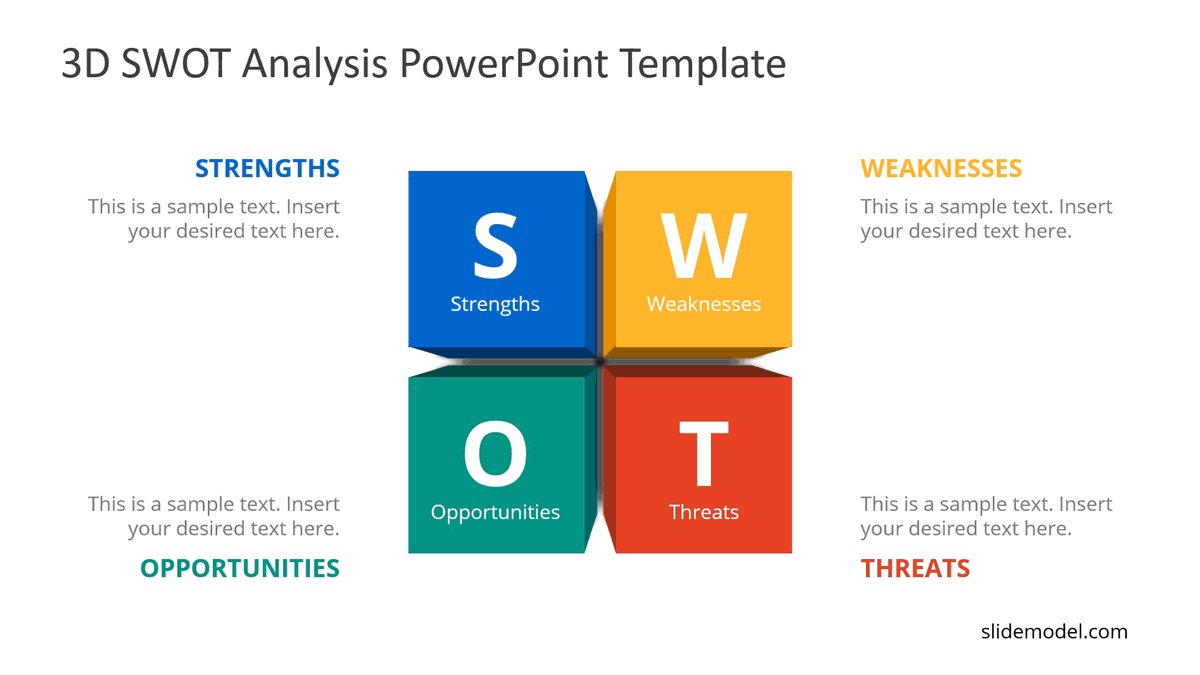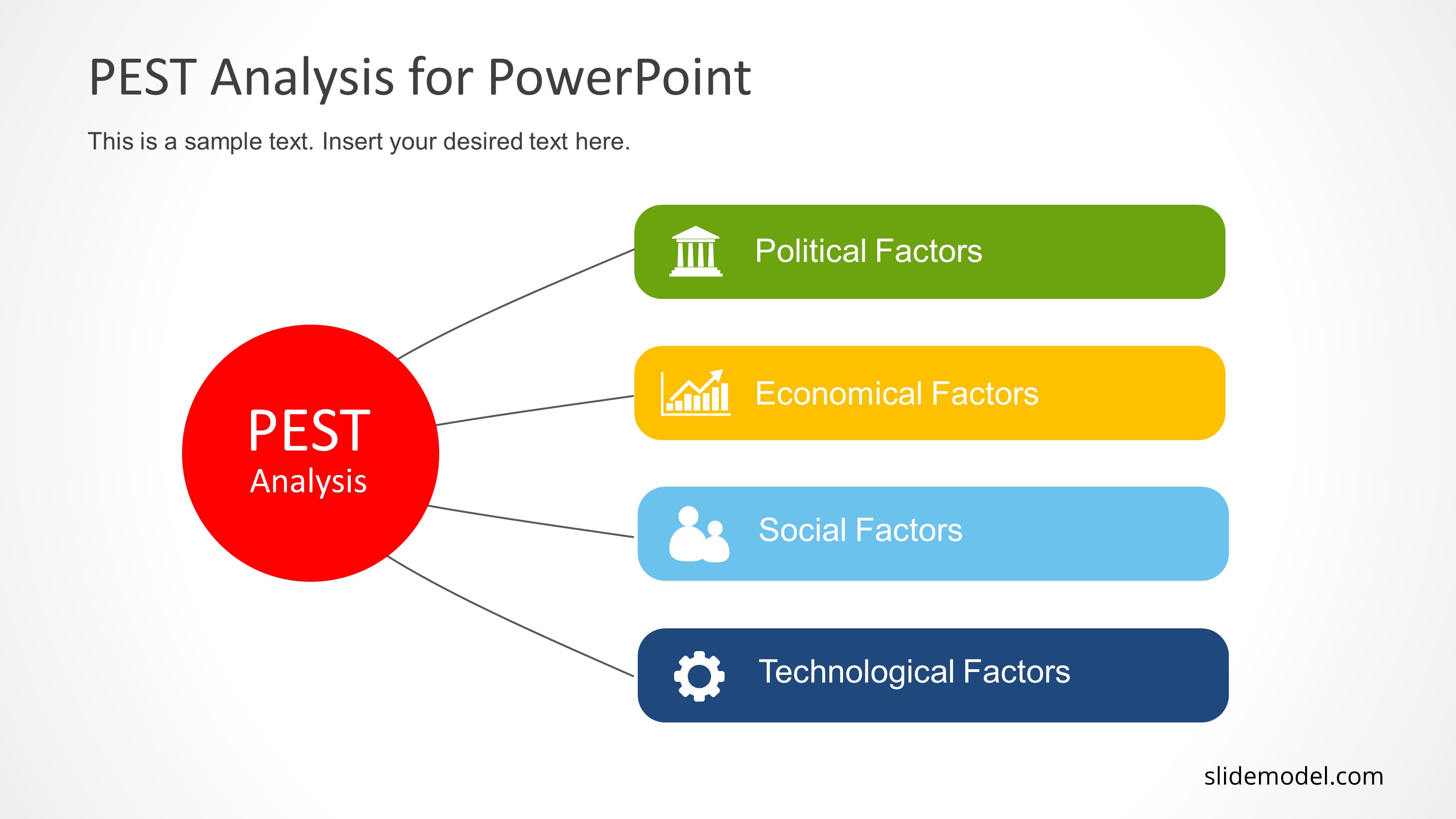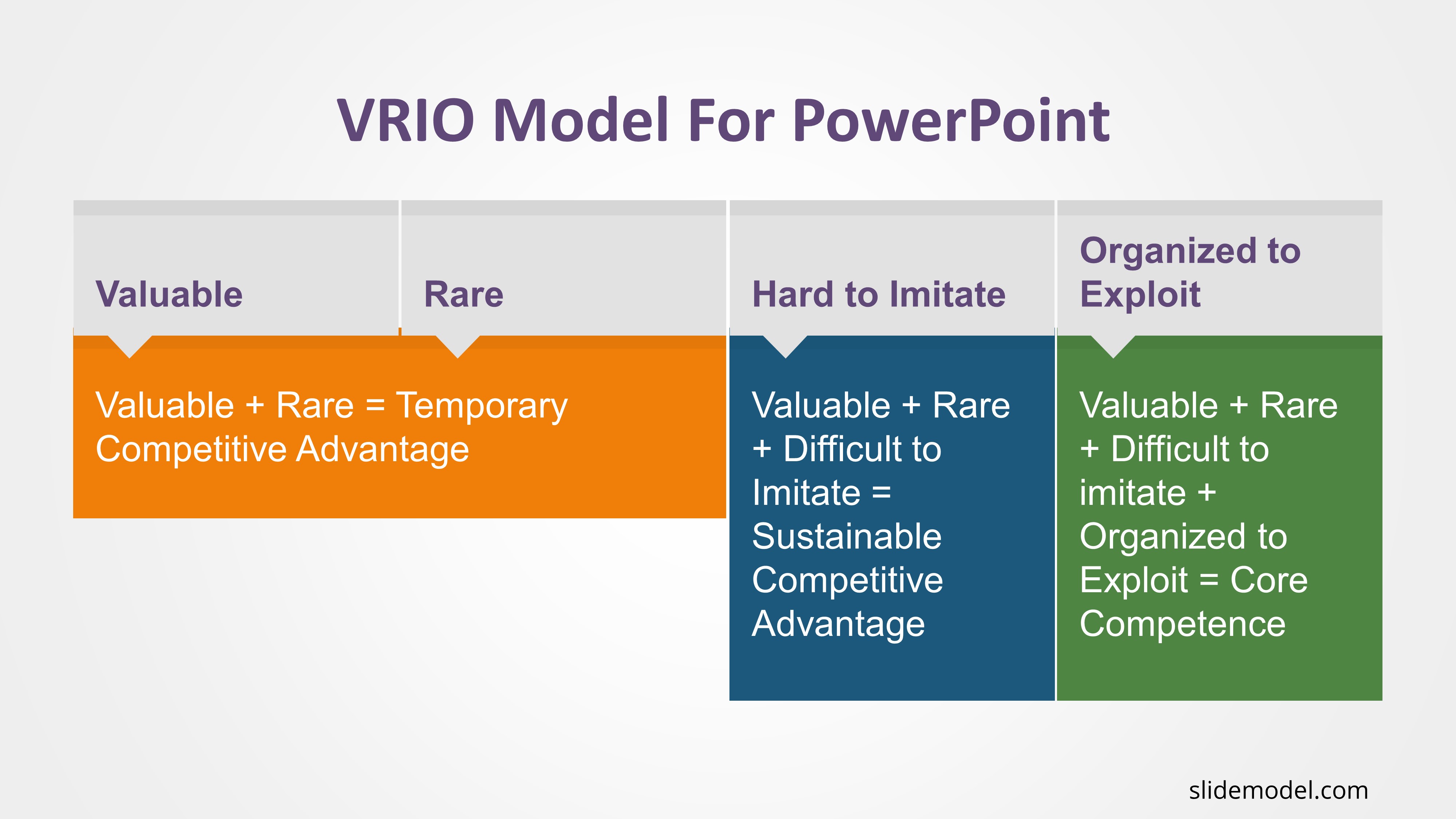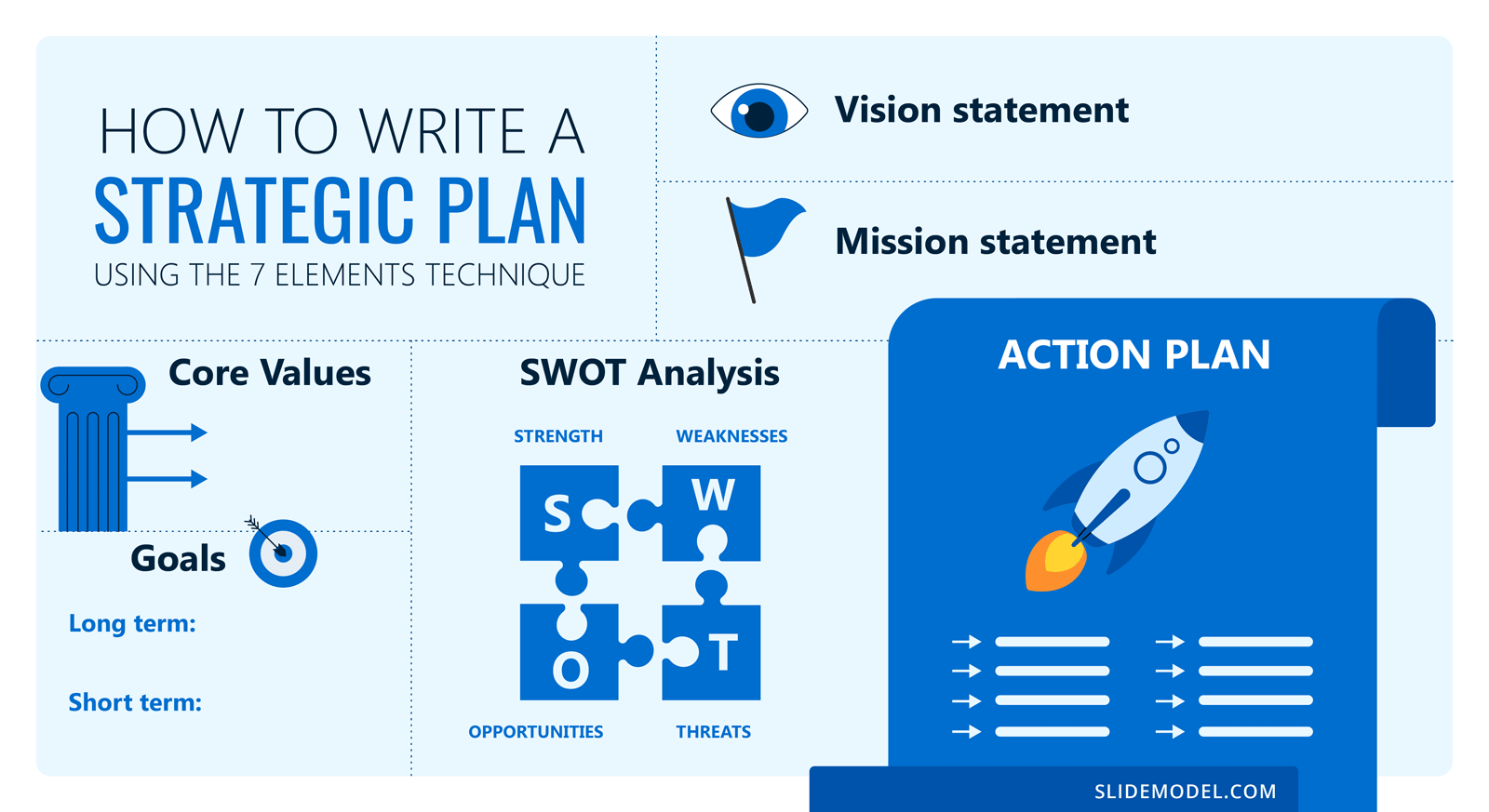
Every organization has grand goals on their business agenda. However, there’s a long way between formulating those goals and seeing the results of their successful accomplishment. A lot of things can happen in-between – the project can get side-tracked, the timeline may change and new threats may emerge. To get a better sense of what needs to be accomplished and how? most managers regularly engage in strategic planning (short and long term).
Table of Content
- What is Strategic Planning?
- Why is Strategic Planning Important?
- Benefits of Strategic Planning
- Business plan vs. Strategic plan: What’s the Difference?
- When Strategic Planning Should Occur?
- The Basics of Strategic Planning: Models and Frameworks
- How to Write a Strategic Plan Using The 7 Elements Technique
- How to Create a One-Page Strategic Plan (OPSP)
- Conclusions
What is Strategic Planning?
A strategic plan is a document that reflects how a company plans to function and grow over a significant period of time, usually three-to-five years. It is based on a mission/vision statement, stated core values, and goals.
A strategic plan also includes all the steps an organization needs to take in order to get where it needs to be. Why is strategic planning important? Because it focuses on an entire organization on long-term goals and allows managers and supervisors to develop plans that will work toward meeting them.
Why is Strategic Planning Important?
Strategic planning serves as the foundation for an organization’s success by providing a clear roadmap for achieving its goals and objectives. It offers several essential benefits that contribute to its significance:
- Proactive Approach: Strategic planning allows organizations to be proactive rather than reactive. By anticipating future challenges and opportunities, organizations can position themselves to capitalize on favorable circumstances and mitigate potential risks.
- Alignment of Efforts: A well-developed strategic plan aligns all departments and functions of an organization toward a common purpose. This alignment fosters unity, reduces silos, and promotes collaboration among teams.
- Resource Allocation: Strategic planning enables organizations to allocate resources effectively by directing investments toward initiatives that align with the overall strategy. This prevents the wastage of resources on unrelated or redundant projects.
- Informed Decision-Making: With a strategic plan in place, decision-makers have a clear framework to guide their choices. This ensures that decisions are consistent with the organization’s long-term goals and vision.
- Performance Measurement: Strategic plans provide measurable goals and objectives, allowing organizations to track their progress and measure success. This measurement provides valuable insights into the effectiveness of strategies and the need for adjustments.
- Engagement and Buy-In: Involving stakeholders in the strategic planning process fosters engagement and ownership. When employees understand the organization’s goals and how their roles contribute, they are more motivated to work toward its success.
- Adaptability: A strategic plan equips organizations with a structured approach to adapt to changing environments. Whether facing disruptions or opportunities, organizations with strategic plans can adjust quickly and effectively.
Benefits of Strategic Planning
- Clear Direction: Strategic planning provides a clear direction for the organization, ensuring that everyone is working towards the same goals.
- Improved Decision-Making: Strategic plans guide decision-making by aligning choices with long-term objectives, reducing uncertainty, and fostering better choices.
- Enhanced Resource Allocation: By identifying priorities and allocating resources strategically, organizations make the most of their available resources.
- Increased Accountability: Clearly defined goals and action plans make it easier to hold individuals and teams accountable for their contributions.
- Better Communication: A strategic plan serves as a communication tool, conveying the organization’s mission, vision, and objectives to stakeholders.
- Cohesive Teamwork: When everyone understands the big picture, collaboration and teamwork improve, leading to more effective outcomes.
- Effective Performance Measurement: Strategic plans provide measurable benchmarks for tracking performance and success over time.
- Flexibility and Adaptability: Strategic plans are designed to be adaptable, allowing organizations to respond to changing circumstances effectively.
- Stakeholder Alignment: Engaging stakeholders in the planning process fosters alignment and commitment to the organization’s goals.
- Competitive Advantage: A well-executed strategic plan positions an organization ahead of competitors by capitalizing on strengths and seizing opportunities.
Business plan vs. Strategic plan: What’s the Difference?
Strategic plans should not be confused with business plans. A business plan is a document that is developed when launching a business describing the business model and its components, explaining the business potential and attempting to raise capital (loans or investment). Once a company is established (up and running), it is time for a detailed strategic plan that would outline growth and perhaps digital transformations.
When Strategic Planning Should Occur?
There is no single time that is right for all businesses, but, rather, it depends on the company’s unique situation and its industry. But there are certain times when it’s worth to think about it:
- If the industry is evolving quickly and competition is becoming brisk.
- At the time of product launch, if the products/services are fully developed, as part of the go-to-market strategy.
- At the beginning of a new fiscal year.
- If government regulations are causing a change in process, production, etc.
- If the company itself is contemplating a new initiative.
- If a previous strategic plan is old and in need of re-evaluation.
So, how does a manager go about designing a strategic plan? The first step would be to choose the right model or framework.
The Basics of Strategic Planning: Models and Frameworks
All strategic plans sit atop of a model and a framework. A model is a structure that you design for your plan, while the strategic planning frameworks are the details that you place within that model to achieve and evaluate progress toward the goals of your plan – for example, specific objectives, action plans, resources, and evaluative process.

Over the years, a number of models and related frameworks have been developed. So, let’s take a look at some of the most popular ones, along with several strategic planning templates, that could help you toward preparing a strategy presentation.
Strategic Planning Models
The Basic Plan: Open up with a mission statement, formulate the mid-range goals, and specify strategies for achieving these. Sometimes, loftier goals may be divided into smaller strategic objectives. In any case, however, there should be action plans for each objective, spelling out what is to be done, when it will be done, and who will be responsible for each task.
The Cascade Strategy Planning Model: The model begins with a vision statement, much like the mission statement in the model above. It states why the organization is in existence. Beyond this, the structure includes value statements/core beliefs, areas for focus (goals), and then specific objectives that are translated to action plans or projects. The model includes lists of KPI’s and how those will be measured.
The Scenario Model: The idea behind this model is to construct a variety of scenarios that could occur due to external events or changes – regulations, demographics, etc. – and make plans for addressing those issues. The business identifies its vulnerabilities or threats, including the best and worst-case outcomes, and then develops a series of action plans for each one. Usually, the scenario model attempts to anticipate issues that might be faced over a long period of time, generally three-to-five years.
The Goal-Based Model: As the title implies, organizations establish prioritized goals/objectives, and then align them with respective action plans. Some goals will be short-term, some – intermediate, and some long-term. The structure is created after goals a prioritized and followed by action plans for achievement. This model also includes monitoring and assessment of progress at stated intervals.
Strategic Planning Frameworks
Remember, frameworks are the actions you will take as you develop your strategic plan and the details that will go into its structure. Here are some of the popular ones in strategic management:
SWOT stands for strengths, weaknesses, opportunities and threats. Strengths and weaknesses are internal conditions; opportunities and threats refer to external forces. Identifying each of these elements will point out to the organization their areas for growth and improvement are and will assist them in developing the goals for their strategic planning.

SWOT Diagram for PowerPoint by SlideModel.
PEST is an acronym for Political, Economic, Socio-cultural, and Technological. These are all external factors that could impact a business, for good or bad. They are identified and plans then made to respond to each factor.

PEST Analysis Template for PowerPoint by SlideModel
Gap Planning: As the name implies, the gap planning framework allows an organization to identify where it is now and where it would like to be at some point in the future. This framework is generally used when internal, not external, conditions can be changed/improved. Check our separate post about how to perform a gap analysis for more insights.

Gap Analysis PowerPoint Template by SlideModel
Blue Ocean: Organizations often live in a red ocean – an environment in which there is lots of competition, and strategic goals must relate to competing in an existing marketplace, beating that competition, and working to gain more of an existing customer base. The goal of this framework is to determine how an organization can move into a blue ocean of new marketplaces and new customer bases.

Blue Ocean Strategy PowerPoint Template by SlideModel
VRIO stands for “value, rarity, imitability, organization.” The framework allows a company to identify opportunities for growth, how to become more competitive with products/services that cannot easily be imitated, and how an organization can be structured to take advantage of the value and rarity it has planned for.

VRIO Model PowerPoint Template by SlideModel
Now that you have some tools and editable strategic planning templates at your disposal, let’s take a closer look at the key strategic planning steps.
How to Write a Strategic Plan Using The 7 Elements Technique
Strategy development and planning are complex tasks and it’s easy to approach them from the wrong angle. The easiest way to approach this task is to base your strategic planning outline around the following 7 elements.

1. A Vision Statement
This is your “big” statement, taking into account what the ultimate goal for your business is. It’s what you want when you finally can say, this organization is a great success.
Here are several inspiring vision statements for reference:
- Teach for America: One day, all children in this nation will have the opportunity to attain an excellent education.
- WWF: We seek to save a planet, a world of life.
- Toms Shoes: The responsibility of providing for the comfort of children in impoverished regions worldwide.
2. The Mission Statement
A mission statement is one of the key elements of a strategy. It helps to formulate and formalize what your organization does, why it does what it does, and who it does it for. What value does your product or service bring to your target customers? What gap in your niche/industry are you filling? How will you improve people’s lives through your product or service? Brainstorm answers to these questions as part of your strategy development session.
3. Core Values
These relate to how you intend to do business and usually reflect a larger picture. Are you committed to product quality? How about diversity? Are environmental sustainability and social responsibility a part of your company’s actions and behaviors? Is full customer satisfaction an abiding focus? Sit down with your team and come up with values to which everyone should commit – three or four that will guide everyone’s behaviors. To complement this section, you can use one of the core values slides for presentations.
4. SWOT Analysis
Performing a SWOT analysis will help you understand how you currently stand out in your niche, what will it take to grow your business further and what vulnerabilities and risks you should address. A standard SWOT analysis accounts for both internal and external factors. To complement this section, you can reuse one of our SWOT slide templates for PowerPoint and Google Slides.
5. Long-Term Goals
Looking beyond just the next year is critical for a business that intends to grow. These may not necessarily be included in your current strategic plan, but you must have those in mind as you develop annual goals/objectives. And you may want to develop a three or five-year strategic plan and then strategic sub-plans on an annual basis.
6. Shorter-Term Goals
These should usually be annual in nature, and they may relate to various parts of an organization, depending on its needs. You might have an annual sales increase goal; you might develop a goal that relates to bringing technology up to date to streamline supply chain management or customer service.
7. Action Plans
Next, for each goal you’ll have to develop an action plan that accounts for the following:
- What activities will occur to bring about the change?
- Who is responsible for the activities that will take place?
- What is the timeline for the completion of the activities?
- What resources (money, staff, etc.) will be required?
- What stakeholders need to be kept informed of activities and progress?
Once you’ve developed a draft, ask the following questions:
- Is the plan clear, and do all participants understand exactly what their roles are?
- Have any outside participants been included (e.g., are there regulatory agencies that must be involved or communicated with)?
- Does the plan anticipate potential events that could have positive or negative progress?
- Is there an activity in place to evaluate progress and success?
These 7 elements are sufficient for creating a detailed 3- to 5-year strategic plan. However, you can also settle for a shorter, more agile version – a one-page strategic plan.
How to Create a One-Page Strategic Plan (OPSP)
Can this even be done, given all that must-go into a strategic plan? The short answer is yes. Verne Harnish, CEO of Gazelles consultancy, originally popularized this concept. His main idea is that if you want to ensure that all people in your company are on board with the new strategy, you should be able to fit it into just one page.
There are plenty of OPSP templates that a manager can use to develop this type of plan, and here are a few tips as one is completed:
- Include mission/vision statement(s) and goals (targets) – include long-term goals and from those the focus goals for the next years.
- Answer the questions who, what, when, where, how, and why relative to goals/action plans.
- Ask and answer the challenging questions: Should We do this? Why? These identify the core values.
- List action plans and responsibilities, as well as time frames.
Note: Full action plans will obviously include much more detail than space will allow on the OPSP. These can be developed separately, including stakeholders in the process, and available for anyone to view if and when they wish.

FAQs
How is a Strategic Plan different from a Business Plan?
– Business Plan: A foundational document created at a company’s inception to explain its business model, potential, and funding needs.
– Strategic Plan: A roadmap for established organizations, focusing on long-term growth, objectives, and actions.
What are the benefits of Strategic Planning?
Key benefits include:
– Clear direction and focus.
– Better decision-making and resource allocation.
– Improved communication and stakeholder alignment.
– Enhanced accountability and performance tracking.
– Competitive advantage through structured planning.
What are common Strategic Planning models?
– Basic Plan: Includes a mission statement, goals, and strategies.
– Cascade Model: Starts with a vision and aligns goals, values, and action plans.
– Scenario Model: Prepares for potential external changes with adaptable plans.
– Goal-Based Model: Prioritizes goals and aligns specific action plans to achieve them.
What should be included in Action Plans?
Action plans should detail:
– Specific activities to achieve goals.
– Assigned responsibilities.
– Required resources (budget, staff, etc.).
– Timelines and deadlines.
– Potential risks and mitigation strategies.
Why is adaptability important in Strategic Planning?
Adaptability ensures that organizations can:
– Respond to unexpected changes in internal or external environments.
– Modify goals or strategies as needed.
– Maintain progress despite disruptions or new opportunities.
Conclusions
Strategic planning is a complex process. It involves many steps and many key elements of a plan, no matter what specific frameworks or templates are chosen for the design and development. To recap, the keys to successful planning are the following:
- Involve as many stakeholders as possible, especially those who will be responsible for managing the implementation and the action plans.
- Involve representatives from top to bottom of an organization, so that there is much buy-in and sense of ownership as possible.
- If a business is new to this process, it may be wise to bring in a strategic planning consultant for the initial plan development.
- Without the element of measuring progress and achievement, a strategic plan is just a document to go into a file. Focus and accountability will just not happen.
Most of all, remember this: strategic plans are not inflexible documents. Internal and external environments change; things just happen. Re-visiting, modifying, and updating will always be necessary.



An excellent summary of how a strategic plan is done. A must have for business administration students.